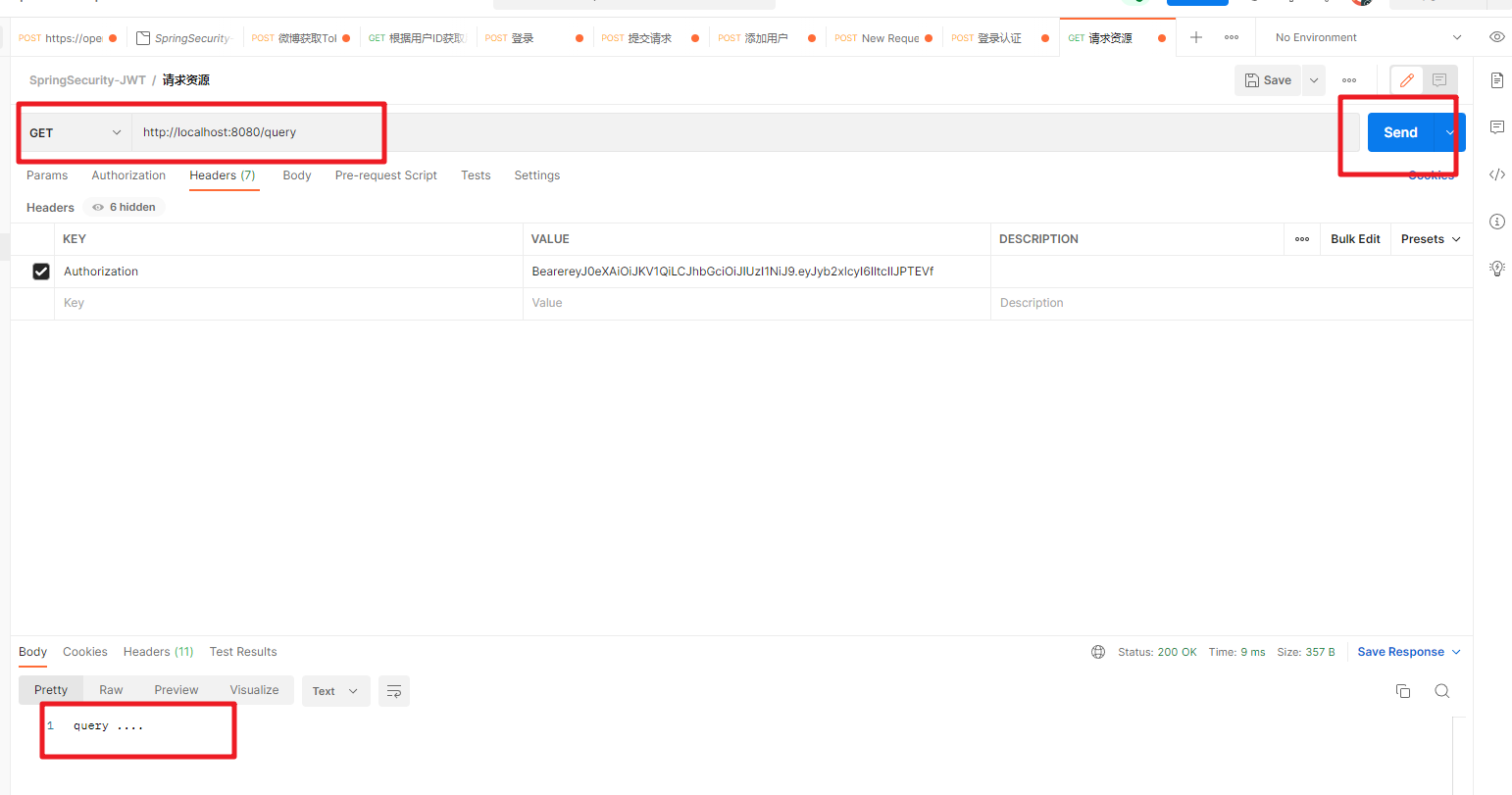SpringSecurity基于JWT实现Token的处理
前面介绍了手写单点登录和JWT的应用,本文结合SpringSecurity来介绍下在SpringBoot项目中基于SpringSecurity作为认证授权框架的情况下如何整合JWT来实现Token的处理。
一、认证思路分析
SpringSecurity主要是通过过滤器来实现功能的!我们要找到SpringSecurity实现认证和校验身份的过滤器!
1.回顾集中式认证流程
用户认证:
使用 UsernamePasswordAuthenticationFilter过滤器中 attemptAuthentication方法实现认证功能,该过滤器父类中 successfulAuthentication方法实现认证成功后的操作。认证失败是在 unsuccessfulAuthentication
身份校验 :
使用 BasicAuthenticationFilter 过滤器中 doFilterInternal方法验证是否登录,以决定能否进入后续过滤器。
2.分析分布式认证流程
用户认证:
由于分布式项目,多数是前后端分离的架构设计,我们要满足可以接受异步post的认证请求参数,需要修改UsernamePasswordAuthenticationFilter过滤器中attemptAuthentication方法,让其能够接收请求体。
另外,默认successfulAuthentication方法在认证通过后,是把用户信息直接放入session就完事了,现在我们需要修改这个方法,在认证通过后生成token并返回给用户。
身份校验:
原来BasicAuthenticationFilter过滤器中doFilterInternal方法校验用户是否登录,就是看session中是否有用户信息,我们要修改为,验证用户携带的token是否合法,并解析出用户信息,交给SpringSecurity,以便于后续的授权功能可以正常使用。
二、具体实现
1.创建项目
创建一个SpringBoot项目.引入必要的依赖
<dependencies>
<dependency>
<groupId>org.springframework.boot</groupId>
<artifactId>spring-boot-starter-security</artifactId>
</dependency>
<dependency>
<groupId>org.springframework.boot</groupId>
<artifactId>spring-boot-starter-web</artifactId>
</dependency>
<dependency>
<groupId>org.projectlombok</groupId>
<artifactId>lombok</artifactId>
<optional>true</optional>
</dependency>
<dependency>
<groupId>org.springframework.boot</groupId>
<artifactId>spring-boot-starter-test</artifactId>
<scope>test</scope>
</dependency>
<dependency>
<groupId>org.springframework.security</groupId>
<artifactId>spring-security-test</artifactId>
<scope>test</scope>
</dependency>
<dependency>
<groupId>com.bobo</groupId>
<artifactId>security-jwt-common</artifactId>
<version>1.0-SNAPSHOT</version>
</dependency>
<dependency>
<groupId>com.alibaba</groupId>
<artifactId>fastjson</artifactId>
<version>1.2.80</version>
</dependency>
<dependency>
<groupId>com.auth0</groupId>
<artifactId>java-jwt</artifactId>
<version>3.4.0</version>
</dependency>
</dependencies>
2.JWT工具类
引入前面创建的JWT的工具类。
import com.auth0.jwt.JWT;
import com.auth0.jwt.JWTCreator;
import com.auth0.jwt.algorithms.Algorithm;
import com.auth0.jwt.exceptions.AlgorithmMismatchException;
import com.auth0.jwt.exceptions.SignatureVerificationException;
import com.auth0.jwt.interfaces.DecodedJWT;
import java.security.SignatureException;
import java.util.Calendar;
import java.util.Map;
public class JWTUtils {
// 秘钥
private static final String SING = "123qwaszx";
/**
* 生成Token header.payload.sing 组成
* @return
*/
public static String getToken(Map<String,String> map){
Calendar instance = Calendar.getInstance();
instance.add(Calendar.DATE,7); // 默认过期时间 7天
JWTCreator.Builder builder = JWT.create();
// payload 设置
map.forEach((k,v)->{
builder.withClaim(k,v);
});
// 生成Token 并返回
return builder.withExpiresAt(instance.getTime())
.sign(Algorithm.HMAC256(SING));
}
/**
* 验证Token
* @return
* DecodedJWT 可以用来获取用户信息
*/
public static DecodedJWT verify(String token){
// 如果不抛出异常说明验证通过,否则验证失败
DecodedJWT verify = null;
try {
verify = JWT.require(Algorithm.HMAC256(SING)).build().verify(token);
}catch (SignatureVerificationException e){
e.printStackTrace();
}catch (AlgorithmMismatchException e){
e.printStackTrace();
}catch (Exception e){
e.printStackTrace();
}
return verify;
}
}
3.用户实例
创建用户的实例,添加必要的属性
@Data
public class UserPojo implements UserDetails {
private Integer id;
private String username;
private String password;
private Integer status;
@JsonIgnore
@Override
public Collection<? extends GrantedAuthority> getAuthorities() {
List<SimpleGrantedAuthority> auth = new ArrayList<>();
auth.add(new SimpleGrantedAuthority("ROLE_ADMIN"));
return auth;
}
@Override
public String getPassword() {
return this.password;
}
@Override
public String getUsername() {
return this.username;
}
@JsonIgnore
@Override
public boolean isAccountNonExpired() {
return true;
}
@JsonIgnore
@Override
public boolean isAccountNonLocked() {
return true;
}
@JsonIgnore
@Override
public boolean isCredentialsNonExpired() {
return true;
}
@JsonIgnore
@Override
public boolean isEnabled() {
return true;
}
}
4.UserService
完成基于SpringSecurity的数据库认证。创建UserService接口并实现
public interface UserService extends UserDetailsService {
}
@Service
public class UserServiceImpl implements UserService {
@Override
public UserDetails loadUserByUsername(String username) throws UsernameNotFoundException {
UserPojo userPojo = new UserPojo();
if("zhang".equals(username)){
userPojo.setUsername("zhang");
userPojo.setPassword("$2a$10$hbMJRuxJoa6kWcfeT7cNPOGdoEXm5sdfSm5DQtp//2cmCF0MHO8b6");
return userPojo;
}
return userPojo;
}
}
5.自定义认证过滤器
在SpringSecurity中的认证是通过UsernamePasswordAuthenticationFilter来处理的,现在我们要通过JWT来处理,那么我们就需要重写其中几个处理的方法
5.1 认证的方法
认证的逻辑还是走的UserService处理,但是我们需要自己来手动的调用认证逻辑。
@Override
public Authentication attemptAuthentication(HttpServletRequest request, HttpServletResponse response)
throws AuthenticationException {
UserPojo sysUser = null;
try {
sysUser = JSON.parseObject(getJson(request), UserPojo.class);
} catch (IOException e) {
e.printStackTrace();
}
UsernamePasswordAuthenticationToken authRequest = new UsernamePasswordAuthenticationToken(sysUser.getUsername(), sysUser.getPassword());
this.setDetails(request, authRequest);
return authenticationManager.authenticate(authRequest);
}
public String getJson(HttpServletRequest request) throws IOException{
BufferedReader streamReader = new BufferedReader( new InputStreamReader(request.getInputStream(), "UTF-8"));
StringBuilder sb = new StringBuilder();
String inputStr;
while ((inputStr = streamReader.readLine()) != null) {
sb.append(inputStr);
}
return sb.toString();
}
5.2 认证成功
认证成功生成Token信息,并保存在响应的header头中。
@Override
protected void successfulAuthentication(HttpServletRequest request
, HttpServletResponse response
, FilterChain chain
, Authentication authResult) throws IOException, ServletException {
// 生成Token信息
Map<String,String> map = new HashMap<>();
map.put("username",authResult.getName());
Collection<? extends GrantedAuthority> authorities = authResult.getAuthorities();
List<String> list = new ArrayList<>();
for (GrantedAuthority authority : authorities) {
list.add(authority.getAuthority());
}
map.put("roles", JSON.toJSONString(list));
String token = JWTUtils.getToken(map);
response.addHeader("Authorization","Bearer"+token);
try {
response.setContentType("application/json;charset=utf-8");
response.setStatus(HttpServletResponse.SC_OK);
PrintWriter out = response.getWriter();
Map<String,Object> resultMap = new HashMap();
resultMap.put("code", HttpServletResponse.SC_OK);
resultMap.put("msg", "认证通过!");
out.write(JSON.toJSONString(resultMap));
out.flush();
out.close();
}catch (Exception outEx){
outEx.printStackTrace();
}
}
5.3 认证失败
认证失败会调用 unsuccess… 方法来处理,那么在这儿我们就需要直接响应了
@Override
protected void unsuccessfulAuthentication(HttpServletRequest request, HttpServletResponse response, AuthenticationException failed) throws IOException, ServletException {
try {
response.setContentType("application/json;charset=utf-8");
response.setStatus(HttpServletResponse.SC_UNAUTHORIZED);
PrintWriter out = response.getWriter();
Map resultMap = new HashMap();
resultMap.put("code", HttpServletResponse.SC_UNAUTHORIZED);
resultMap.put("msg", "用户名或密码错误!");
out.write(new ObjectMapper().writeValueAsString(resultMap));
out.flush();
out.close();
}catch (Exception outEx){
outEx.printStackTrace();
}
}
完整代码:
package com.bobo.jwt.filter;
public class TokenLoginFilter extends UsernamePasswordAuthenticationFilter {
private AuthenticationManager authenticationManager;
public TokenLoginFilter(AuthenticationManager authenticationManager){
this.authenticationManager = authenticationManager;
}
/**
* 具体认证的方法
* @param request
* @param response
* @return
* @throws AuthenticationException
*/
@Override
public Authentication attemptAuthentication(HttpServletRequest request, HttpServletResponse response)
throws AuthenticationException {
UserPojo sysUser = null;
try {
sysUser = JSON.parseObject(getJson(request), UserPojo.class);
} catch (IOException e) {
e.printStackTrace();
}
UsernamePasswordAuthenticationToken authRequest = new UsernamePasswordAuthenticationToken(sysUser.getUsername(), sysUser.getPassword());
this.setDetails(request, authRequest);
return authenticationManager.authenticate(authRequest);
}
@Override
protected void unsuccessfulAuthentication(HttpServletRequest request, HttpServletResponse response, AuthenticationException failed) throws IOException, ServletException {
try {
response.setContentType("application/json;charset=utf-8");
response.setStatus(HttpServletResponse.SC_UNAUTHORIZED);
PrintWriter out = response.getWriter();
Map resultMap = new HashMap();
resultMap.put("code", HttpServletResponse.SC_UNAUTHORIZED);
resultMap.put("msg", "用户名或密码错误!");
out.write(new ObjectMapper().writeValueAsString(resultMap));
out.flush();
out.close();
}catch (Exception outEx){
outEx.printStackTrace();
}
}
public String getJson(HttpServletRequest request) throws IOException{
BufferedReader streamReader = new BufferedReader( new InputStreamReader(request.getInputStream(), "UTF-8"));
StringBuilder sb = new StringBuilder();
String inputStr;
while ((inputStr = streamReader.readLine()) != null) {
sb.append(inputStr);
}
return sb.toString();
}
/**
* 登录成功后的处理
* @param request
* @param response
* @param chain
* @param authResult
* @throws IOException
* @throws ServletException
*/
@Override
protected void successfulAuthentication(HttpServletRequest request
, HttpServletResponse response
, FilterChain chain
, Authentication authResult) throws IOException, ServletException {
// 生成Token信息
Map<String,String> map = new HashMap<>();
map.put("username",authResult.getName());
Collection<? extends GrantedAuthority> authorities = authResult.getAuthorities();
List<String> list = new ArrayList<>();
for (GrantedAuthority authority : authorities) {
list.add(authority.getAuthority());
}
map.put("roles", JSON.toJSONString(list));
String token = JWTUtils.getToken(map);
response.addHeader("Authorization","Bearer"+token);
try {
response.setContentType("application/json;charset=utf-8");
response.setStatus(HttpServletResponse.SC_OK);
PrintWriter out = response.getWriter();
Map<String,Object> resultMap = new HashMap();
resultMap.put("code", HttpServletResponse.SC_OK);
resultMap.put("msg", "认证通过!");
out.write(JSON.toJSONString(resultMap));
out.flush();
out.close();
}catch (Exception outEx){
outEx.printStackTrace();
}
}
}
6.自定义校验过滤器
然后就是当客户端提交请求,我们需要拦截请求检查header头中是否携带了对应的Token信息,并检查是否合法。
/**
* 校验Token是否合法的Filter
*/
public class TokenVerifyFilter extends BasicAuthenticationFilter {
public TokenVerifyFilter(AuthenticationManager authenticationManager) {
super(authenticationManager);
}
@Override
protected void doFilterInternal(HttpServletRequest request, HttpServletResponse response, FilterChain chain) throws IOException, ServletException {
String header = request.getHeader("Authorization");
if (header == null || !header.startsWith("Bearer")) {
//如果携带错误的token,则给用户提示请登录!
chain.doFilter(request, response);
response.setContentType("application/json;charset=utf-8");
response.setStatus(HttpServletResponse.SC_FORBIDDEN);
PrintWriter out = response.getWriter();
Map resultMap = new HashMap();
resultMap.put("code", HttpServletResponse.SC_FORBIDDEN);
resultMap.put("msg", "请登录!");
out.write(JSON.toJSONString(resultMap));
out.flush();
out.close();
} else {
//如果携带了正确格式的token要先得到token
String token = header.replace("Bearer", "");
//验证tken是否正确
DecodedJWT verify = JWTUtils.verify(token);
String userName = verify.getClaim("username").asString();
String roleJSON = verify.getClaim("roles").asString();
System.out.println("roleJSON = " + roleJSON);
List<String> roleArray = JSON.parseArray(roleJSON,String.class);
List<SimpleGrantedAuthority> list = new ArrayList<>();
for (String s : roleArray) {
list.add(new SimpleGrantedAuthority(s));
}
UsernamePasswordAuthenticationToken authResult =
new UsernamePasswordAuthenticationToken(userName, null, list);
SecurityContextHolder.getContext().setAuthentication(authResult);
chain.doFilter(request, response);
}
}
}
7.配置类
然后我们需要添加SpringSecurity的配置类,添加自定义的过滤器
@Configuration
@EnableWebSecurity
@EnableGlobalMethodSecurity(prePostEnabled = true)
public class SpringSecurityWebConfig extends WebSecurityConfigurerAdapter {
@Autowired
private UserService userService;
@Bean
public BCryptPasswordEncoder passwordEncoder(){
return new BCryptPasswordEncoder();
}
//指定认证对象的来源
public void configure(AuthenticationManagerBuilder auth) throws Exception {
auth.userDetailsService(userService).passwordEncoder(passwordEncoder());
}
//SpringSecurity配置信息
public void configure(HttpSecurity http) throws Exception {
http.csrf()
.disable()
.authorizeRequests()
.antMatchers("/user/query").hasAnyRole("ADMIN")
.anyRequest()
.authenticated()
.and()
.addFilter(new TokenLoginFilter(super.authenticationManager()))
.addFilter(new TokenVerifyFilter(super.authenticationManager()))
.sessionManagement().sessionCreationPolicy(SessionCreationPolicy.STATELESS);
}
}
8.Controller
为了便于测试,我们添加了一个Controller,如下:
@RestController
public class UserController {
@PreAuthorize(value = "hasAnyRole('ROLE_ADMIN')")
@GetMapping("/query")
public String query(){
System.out.println("---------->query");
return "query .... ";
}
@PreAuthorize(value = "hasAnyRole('ROOT')")
@GetMapping("/update")
public String update(){
System.out.println("---------->update");
return "update .... ";
}
@GetMapping("/save")
public String save(){
System.out.println("---------->save");
return "save .... ";
}
}
9.测试
我们通过Postman来调试,首先登录测试:

同时在header中可以获取对应的Token信息

然后根据返回的Token来测试访问Controller的接口

有权限的能正常访问,没有权限的就访问不了。搞定!!!






















 676
676











 被折叠的 条评论
为什么被折叠?
被折叠的 条评论
为什么被折叠?








